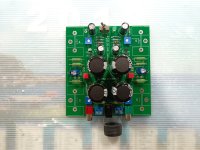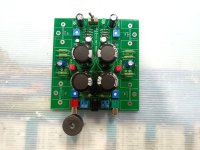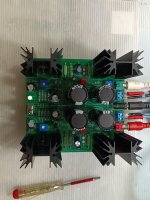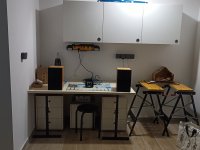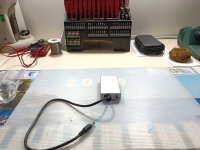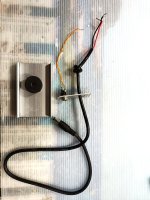Thank you @lastnamenelson and @barryso
The mid century mini will have some mods, this the first waf-step. She has designed the stereo set and the mini should take notice about that.
The Thorens is the juke box model (TD224), made in the french speaking part, where the watchmakers live. I‘ve read, this model was inspired by some important people living in Paris. They wanted before, between and after the sets in the jazz clubs some music from records without the need of a disc jockey
The mid century mini will have some mods, this the first waf-step. She has designed the stereo set and the mini should take notice about that.
The Thorens is the juke box model (TD224), made in the french speaking part, where the watchmakers live. I‘ve read, this model was inspired by some important people living in Paris. They wanted before, between and after the sets in the jazz clubs some music from records without the need of a disc jockey
I've been really enjoying this Amp running it biased at .3 volts while it gets to about 135 F. I grabbed a Woozoo fan at Costco today and set it up in front of the amp. Now I have it running at .35 volts at about 100 F. Is this as high as I should try to bias it or how high can it comfortably run? I admit I do enjoy it better at .35v vs .30v.
@lastnamenelson
Beside the purchases of the TD224 and the mini, the price paid is similar (in 1990 and 2024), the mini is not so cool, it’s the ,hottest‘ amp for me🙂-)) and every time it’s good for a surprise, when I listen to music which I know very well and still can explore new sounds.
Thank you @nelson and everyone for their wonderful contribution
Beside the purchases of the TD224 and the mini, the price paid is similar (in 1990 and 2024), the mini is not so cool, it’s the ,hottest‘ amp for me🙂-)) and every time it’s good for a surprise, when I listen to music which I know very well and still can explore new sounds.
Thank you @nelson and everyone for their wonderful contribution
@100ohms: Wow! You got a good deal on the Thorens. Perhaps it was a fixer-upper.
As for the sound of familiar music on the DIY ACA Mini, I have to agree that it is a whole new experience. The soundstage is amazing, and lots of subtilty is revealed. For example, I listened to some lute music two days ago. Just great!
The only shortcoming I run into is that the Mini lacks the muscle (Nelson's word in a message to me) to make loud, complex passages seem loud and complex. It is perhaps a bit too refined for that.
But I still maintain the the ACA Mini is the best amplifier I've ever heard in my house.
As for the sound of familiar music on the DIY ACA Mini, I have to agree that it is a whole new experience. The soundstage is amazing, and lots of subtilty is revealed. For example, I listened to some lute music two days ago. Just great!
The only shortcoming I run into is that the Mini lacks the muscle (Nelson's word in a message to me) to make loud, complex passages seem loud and complex. It is perhaps a bit too refined for that.
But I still maintain the the ACA Mini is the best amplifier I've ever heard in my house.
@lastnamenelson
In my musicroom, with Triaxiom 1220c (12“/20 Watts/15 Ohm)speakers I haven’t missed anything. When I listened to Yusef Lateefs Suite 16, the symphonic blues suite I was very impressed about the muscles of the mini in complex music. Normally I do listen there with the ACA and B1K. The ACA has a little bit better attack, the mini resolves nicer and high efficiency speakers with big woofer will play a role with the mini.
In my musicroom, with Triaxiom 1220c (12“/20 Watts/15 Ohm)speakers I haven’t missed anything. When I listened to Yusef Lateefs Suite 16, the symphonic blues suite I was very impressed about the muscles of the mini in complex music. Normally I do listen there with the ACA and B1K. The ACA has a little bit better attack, the mini resolves nicer and high efficiency speakers with big woofer will play a role with the mini.
@100ohms: Yes, I understand that the key to getting the best out of a low-powered amplifier is having very sensitive speakers. Mine are two-way, 8 Ohm floor standers with 7 inch woofers. They are pretty easy to drive, but not "to the limit." For that, they need more power.
I made note of Yusef Lateef's Suite 16. Always open to trying new music!
I made note of Yusef Lateef's Suite 16. Always open to trying new music!
Well, you've certainly asked the wrong old man to do a sketch for you, but I'm happy to write up my plan of attack in some detail:@Skip Pack , Like your idea but having a hard time visualizing the setup. Have you a rough hand drawn diagram showing the copper interface with the heatsinks.
Cheers
I measured the center space between the fins on the heatsink where the mosfet mounts on one of my ACA minis, and it look like a flat piece of metal about 5/8" wide would fit easily, 15mm moreso. I will be looking for what is perhaps 1/2" to 5/8" wide .08-.125" thick flat aluminum or copper bar planning to use two pieces 2.5-3 inches long per heatsink. That's 8 pieces per ACA Mini. (I have 3). Copper is more desirable thermally, but I will use what I can find what suits dimensionally. Big industrial metal suppliers often buy unused surplus, often cutoffs and have sections you can browse. Those are usually the cheapest places and are more likely to have copper, brass, and so on.
Most retail hardware stores and home superstores like Home Depot will have aluminum lengths, so 1/2" inch wide pieces are likely easy to find and not to costly. Onlinemetals is a place I just checked out and the raw prices are sane. Don't know about the shipping.
I would look to see how much will fit above the mounted mosfets on your ACA Mini and about double that distance to determine the length of each piece (my guess without measuring today is the 2.5 to 3.0 inches mentioned above.) I would then use a hacksaw or power jigsaw to cut out the 24 pieces I need. Sounds like I'm going for the cheaper aluminum.
I will then take two pieces and clamp them together in anticipation of drilling a hole through both the same diameter as the hole in the heatsink that is used to mount the mosfet. Of course you will use the new heatsink that you will be stacking on your already mounted sinks to locate this hole. The vertical placement of that hole would allow the pieces of metal to cover an equal vertical distance on the old and new sinks.
Once the hole is located and drilled through the two clamped pieces, I'll clean up the burrs and then use a #6-32 X 3/8" screw and nut to mount the pieces of metal together, and drill another hole of the same diameter about 1/2" up from the other end of the pieces (which will clamp on the existing sink on your ACA Mini) After the second, lower hole is drilled in the two piece, you can mount the pieces to the new sink loosely using the same screw and nut, slide the pieces over the existing heatsink and tighten the screw on the upper sink. The pins in the sink and the clamping force from the upper screw should let you drill a hole in the lower sink using the existing hole you just drilled as a pilot. I'll be using my shop vac to pull the chips while drilling to avoid potential shorts. once the hole is drilled through the lower sink, you may need to loosen the upper screw to align the hole in side from which you have drilled in the lower sink with the previously drilled hole in piece on the back side. Once you can put a lower screw through you are about done. I'd take it apart, clean up burrs, possibly paint the strips (but not the side against the sinks), apply some goop and clamp the assembly together, calling it done.
I don't know if I've seen a statement from anyone stating a maximum ampereage for best audio quality given adequate rejection. I hope we can check out .4 amps at the test point or more and get some listening feedback.
I apologize for this over-detailed description for something that's fairly obvious, but it never hurts to actually write it out.
Hi all, I've been interested in building a new system. It's been a number of years (decades). I enjoyed building and listening to speakers and amps when I was much younger and miss it, a lot. I live in Esperance Wester Australia, long way from anywhere, so limited listening opportunities. I was thinking the mini aca and matching it with the fugalhorn fhxl 10p to start, then possible work on an Aleph j or something with a bit more drive.
From an audio equipment perspective, I have a very limited budget, and thought this a way into something that I can sit in the dark with Miles Davis and Ella, and loose the world for a few moments. And I love building.
I'm more interested in quality than quantity. I play the trumpet and enjoy jazz, classical and instrumental guitar etc.
I tried some searches and such but didn't find what I was looking for.
Does this match-up make sense or should I be looking at something else?
Has anyone used this amp and speaker together, and what was the impression?
If I'm in the wrong thread please direct me to the right one, this is my first input at this site. There are so many pages I don't know where to start.
From an audio equipment perspective, I have a very limited budget, and thought this a way into something that I can sit in the dark with Miles Davis and Ella, and loose the world for a few moments. And I love building.
I'm more interested in quality than quantity. I play the trumpet and enjoy jazz, classical and instrumental guitar etc.
I tried some searches and such but didn't find what I was looking for.
Does this match-up make sense or should I be looking at something else?
Has anyone used this amp and speaker together, and what was the impression?
If I'm in the wrong thread please direct me to the right one, this is my first input at this site. There are so many pages I don't know where to start.
What happens, technically, if I substitute C2 (output capacitor) with another with lesser capacitance? From 15k uF to 4,7k uF.
Thinking of: 4700uF, 35V; Nichicon KG series.
Thinking of: 4700uF, 35V; Nichicon KG series.
Not much will happen.
C2 forms a HPF with R7 which is set at probably a decade lower frequency than the input filter of the amp, which in turn determines the LF cut off frequency.
Find an online calculator for the exact numbers.
C2 forms a HPF with R7 which is set at probably a decade lower frequency than the input filter of the amp, which in turn determines the LF cut off frequency.
Find an online calculator for the exact numbers.
4700uF is still pretty large in the scheme of things but technically you reduce the low frequency response of the amp. By how much depends on your speaker impedance. Would notice the difference? I suspect not in the majority of cases.
This is with a 'tough' speaker load, first 15000uF and then 4700uF. Look at the response below around 30Hz.


And into a resistive 8 ohm load with 15000uF and then 4700uF:


This is with a 'tough' speaker load, first 15000uF and then 4700uF. Look at the response below around 30Hz.
And into a resistive 8 ohm load with 15000uF and then 4700uF:
C2 forms a HPF with R7 which is set at probably a decade lower frequency than the input filter of the amp, which in turn determines the LF cut off frequency.
The input filter allows pretty extended LF response of approx 1.4Hz by calculation taking the input impedance as 111.5k
Thank you very much! This is what is was hoping for.This is with a 'tough' speaker load, first 15000uF and then 4700uF. Look at the response below around 30Hz.
Klipsch Heresy don't say much under 50 Hz. I can live with cut-off around 30Hz with C2 = 4700 uF.
It's easier to get high quality electrolytic capacitors with lesser capacitance. Just trying to optimize my modest set-up. And will try a combination of Nichicon and Audio Note Kaisei as C2.
@Skip Pack , thanks for the detailed description. Good luck with your modification if you choose to do it. When I read your original post, I thought that you were going the screw a metal plate to the top of the old and bottom of the new heat sink, using the pin holes. Then you would bolt the 2 pieces of metal together (assuming you had cut the metal to extend beyond the fins). If you used copper, it should add some weight and the structure should be fairly rigid /stable. Funny how the mind works 🙂
Cheers
Cheers
Always late to join the party, but here comes my ACA Mini build.
Everything has already been said, but hopefully I can encourage new builders to build this tiny… but truly great amp.
I went for the essential kit. For various reasons (thinking bi-amp experimentation for the sake of fun with 1 or 2 SMPS) I went for a big 5A low ripple Meanwell PS (GST120A24). I used the big caps as initially intended and the latest resistor tweak. Finally, I wanted to experiment something regarding SMPS filtering, with 3 filters. More to follow.
The soldering on the board is really very easy for everyone. The kits provided here are so great and easy going, thanks papa and DIYA!
Well, it is perhaps too easy for old guys like me as I decided to have it done quickly in one eve while everyone was sleeping here. That meant somehow soldering the 4 small transistors after midnight and while everything looked symmetrical… I noticed at 1 am it wasn’t. 2 of these tiny parts face in one direction, 2 obviously in the other –I noticed it while soldering the 4th one, so lucky me only one to resolder and no drama, but future builders keep it in mind… it is sooo quick to assemble one may skip that.
As Jim / 6L6 said in his excellent build guide, heatsinks are just that… be armed with patience and a lot of time. I cranked my soldering iron to 410°C while it had the largest tip on it. It works after a while, I found that removing the soldering iron here and there, soldering by bits, helped.
All has been said regarding adjustments. I did it relaxed, during 2 days, enabling it to settle. I went for 344mV & 11,53V on one channel and 345mV & 11,49v on the other. I wanted the bias to be very close and not to exceed 50°C at 23°C room temp.
I didn’t yet have the time to assess its sonic quality, nor to compare it to my VFET. My next step is anyway to have it on top form, trying the various PS filters I have. But other than that there is nothing to tweak / add: there is enough to play with bias and jumpers.
Short spoiler though to encourage people to build it: it is really nice and tiny, so easy to build… and for sure very very musical and special. Can’t say if it is very euphonic at this stage, but on my dummy LS the sound is usually quite… awfull. I fixed a nice little amp last week, one I know by heart -my mother’s midly tweaked HK620 - , and it confirmed it again LOL. Well, with the ACA Mini warmed up the sound was amazingly on the border of engaging while also loud enough! Something is defo going on…
More to follow re listening impressions and SMPS filtering
Claude
Everything has already been said, but hopefully I can encourage new builders to build this tiny… but truly great amp.
I went for the essential kit. For various reasons (thinking bi-amp experimentation for the sake of fun with 1 or 2 SMPS) I went for a big 5A low ripple Meanwell PS (GST120A24). I used the big caps as initially intended and the latest resistor tweak. Finally, I wanted to experiment something regarding SMPS filtering, with 3 filters. More to follow.
The soldering on the board is really very easy for everyone. The kits provided here are so great and easy going, thanks papa and DIYA!
Well, it is perhaps too easy for old guys like me as I decided to have it done quickly in one eve while everyone was sleeping here. That meant somehow soldering the 4 small transistors after midnight and while everything looked symmetrical… I noticed at 1 am it wasn’t. 2 of these tiny parts face in one direction, 2 obviously in the other –I noticed it while soldering the 4th one, so lucky me only one to resolder and no drama, but future builders keep it in mind… it is sooo quick to assemble one may skip that.
As Jim / 6L6 said in his excellent build guide, heatsinks are just that… be armed with patience and a lot of time. I cranked my soldering iron to 410°C while it had the largest tip on it. It works after a while, I found that removing the soldering iron here and there, soldering by bits, helped.
All has been said regarding adjustments. I did it relaxed, during 2 days, enabling it to settle. I went for 344mV & 11,53V on one channel and 345mV & 11,49v on the other. I wanted the bias to be very close and not to exceed 50°C at 23°C room temp.
I didn’t yet have the time to assess its sonic quality, nor to compare it to my VFET. My next step is anyway to have it on top form, trying the various PS filters I have. But other than that there is nothing to tweak / add: there is enough to play with bias and jumpers.
Short spoiler though to encourage people to build it: it is really nice and tiny, so easy to build… and for sure very very musical and special. Can’t say if it is very euphonic at this stage, but on my dummy LS the sound is usually quite… awfull. I fixed a nice little amp last week, one I know by heart -my mother’s midly tweaked HK620 - , and it confirmed it again LOL. Well, with the ACA Mini warmed up the sound was amazingly on the border of engaging while also loud enough! Something is defo going on…
More to follow re listening impressions and SMPS filtering
Claude
Attachments
@Andy999
You and I are on similar tracks except I've been gradually drifting towards a balanced system feeding the FHXLs (with a 10.3M in my case).
I've settled on the middle ground -- ACA monoblocks based on Nelson Brock's Redux version.
Nelson also has a version of the ACA mini.
Maybe worth looking at...
https://reduxkits.com/
You and I are on similar tracks except I've been gradually drifting towards a balanced system feeding the FHXLs (with a 10.3M in my case).
I've settled on the middle ground -- ACA monoblocks based on Nelson Brock's Redux version.
Nelson also has a version of the ACA mini.
Maybe worth looking at...
https://reduxkits.com/
Now to the PS filtering options. To start with, I will have 2 (identical) of Mark’s excellent SMPS filters on hand (see thread... and shop here). I build over a dozen of them and they never failed to deliver. 2 enable daisy chaining, fun to try.
As one can see in my previous post, I have positioned a relatively big coil in front of the ACA Mini - just to give a sense of its size. This is Murata 1433428C, a part I found quite suited for a test around this build. I wanted initially to modify slightly the ACA Mini board to have 2 of these fitted (one per channel) and also easily removable to enable quick listening comparisons.
While doing this, I came across a post from Mark J (again our filtering genius), who mentioned this part… and its use to filter an amp! I sadly didn’t copy it, nor do I remember if it was a comment for the ACA Mini or for an other ACA amp derivative. BUT the point is his post defo gave me the idea to change my plans and to use only one coil upstream of the amp… in my case offboard, in front of the ACA Mini in a small and easily removable casing similar to the ones I use for the usual SMPS filters. Let’s put it this way: should that coil filtering work / bring some sonic benefits, then full credits should go again to Mark J – and if it doesn’t, then it was just another wrong idea of mine LOL
Anyway, on top of the jumpers (I suspect preferences here could be LS related, big LS jumpers in, small fun LS jumpers out?), we will have with friends a total of 3 PS filters to try (one being different and having a knot), each easily and quickly removable (plug in / plug out) and all of these can be combined in whatever order we want between the SMPS and the ACA Mini.
Sounds like a fun workshop in the coming weeks…
Claude
As one can see in my previous post, I have positioned a relatively big coil in front of the ACA Mini - just to give a sense of its size. This is Murata 1433428C, a part I found quite suited for a test around this build. I wanted initially to modify slightly the ACA Mini board to have 2 of these fitted (one per channel) and also easily removable to enable quick listening comparisons.
While doing this, I came across a post from Mark J (again our filtering genius), who mentioned this part… and its use to filter an amp! I sadly didn’t copy it, nor do I remember if it was a comment for the ACA Mini or for an other ACA amp derivative. BUT the point is his post defo gave me the idea to change my plans and to use only one coil upstream of the amp… in my case offboard, in front of the ACA Mini in a small and easily removable casing similar to the ones I use for the usual SMPS filters. Let’s put it this way: should that coil filtering work / bring some sonic benefits, then full credits should go again to Mark J – and if it doesn’t, then it was just another wrong idea of mine LOL
Anyway, on top of the jumpers (I suspect preferences here could be LS related, big LS jumpers in, small fun LS jumpers out?), we will have with friends a total of 3 PS filters to try (one being different and having a knot), each easily and quickly removable (plug in / plug out) and all of these can be combined in whatever order we want between the SMPS and the ACA Mini.
Sounds like a fun workshop in the coming weeks…
Claude
Attachments
- Home
- Amplifiers
- Pass Labs
- DIY ACA mini
